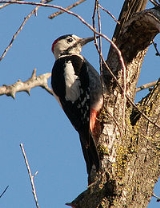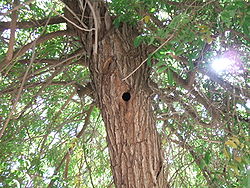
Syrian Woodpecker
Encyclopedia
The Syrian Woodpecker (Dendrocopos syriacus) is a member of the woodpecker
family, the Picidae
.
from southeastern Europe
east to Iran
. Its range has expanded further northwest into Europe in recent years. It is an inhabitant of open woodlands, cultivation with trees and scrubs, and parks, depending for food and nesting sites upon old trees. It is often an inconspicuous bird
, in spite of the plumage. The large white shoulder patch is a feature that catches the eye.
, Dendrocopos major. The upper parts of the male are glossy black, with a crimson spot on the nape and white on the sides of the face and neck. On the shoulder is a large white patch and the flight feathers are barred with black and white. The three outer tail feathers show only a few white spots; these show when the short stiff tail is outspread, acting as a support in climbing. The under parts are buffish white, the abdomen and under tail coverts reddish. The long bill is slate black and the legs greenish grey. The female has no crimson on the nape, and in the young this nape spot is absent, but the crown is crimson.it differs from the smaller Lesser Spotted Woodpecker
by the crimson on the abdomen.
It is much harder to distinguish Syrian Woodpecker from Great Spotted Woodpecker. Syrian has a longer bill, and lacks the white tail barring of Great Spotted. Another important distinction is that Syrian does not have the black line connecting the moustachial stripe to the nape shown by the more widespread species.
. The call is a sharp quit, quit, softer than Great Spotted Woodpecker, and something like Common Redshank
.
s which bore into the timber of forest trees, such as the larva
e of wood boring moth
s and beetle
s. The woodpecker usually alights on the trunk, working upwards. During the ascent it taps the bark, breaking off fragments, but often extracts its prey from crevices with the tip of its sticky tongue. Seeds, nut
s and berries are eaten when insect food is scarce. Its actions are jerky, and it hops rather than climbs, leaping forward with one foot just in advance of the other. When a space is crossed the flight is easy and undulating.

Woodpecker
Woodpeckers are near passerine birds of the order Piciformes. They are one subfamily in the family Picidae, which also includes the piculets and wrynecks. They are found worldwide and include about 180 species....
family, the Picidae
Picidae
The woodpeckers, piculets and wrynecks are a family, Picidae, of near-passerine birds. Members of this family are found worldwide, except for Australia and New Zealand, Madagascar, and the extreme polar regions...
.
Distribution and habitat
The woodpecker is a resident breeding birdBird
Birds are feathered, winged, bipedal, endothermic , egg-laying, vertebrate animals. Around 10,000 living species and 188 families makes them the most speciose class of tetrapod vertebrates. They inhabit ecosystems across the globe, from the Arctic to the Antarctic. Extant birds range in size from...
from southeastern Europe
Europe
Europe is, by convention, one of the world's seven continents. Comprising the westernmost peninsula of Eurasia, Europe is generally 'divided' from Asia to its east by the watershed divides of the Ural and Caucasus Mountains, the Ural River, the Caspian and Black Seas, and the waterways connecting...
east to Iran
Iran
Iran , officially the Islamic Republic of Iran , is a country in Southern and Western Asia. The name "Iran" has been in use natively since the Sassanian era and came into use internationally in 1935, before which the country was known to the Western world as Persia...
. Its range has expanded further northwest into Europe in recent years. It is an inhabitant of open woodlands, cultivation with trees and scrubs, and parks, depending for food and nesting sites upon old trees. It is often an inconspicuous bird
Bird
Birds are feathered, winged, bipedal, endothermic , egg-laying, vertebrate animals. Around 10,000 living species and 188 families makes them the most speciose class of tetrapod vertebrates. They inhabit ecosystems across the globe, from the Arctic to the Antarctic. Extant birds range in size from...
, in spite of the plumage. The large white shoulder patch is a feature that catches the eye.
Description
The woodpecker is 23–25 cm long, and is very similar to the Great Spotted WoodpeckerGreat Spotted Woodpecker
The Great Spotted Woodpecker , Dendrocopos major, is a bird species of the woodpecker family . It is distributed throughout Europe and northern Asia, and usually resident year-round except in the colder parts of its range...
, Dendrocopos major. The upper parts of the male are glossy black, with a crimson spot on the nape and white on the sides of the face and neck. On the shoulder is a large white patch and the flight feathers are barred with black and white. The three outer tail feathers show only a few white spots; these show when the short stiff tail is outspread, acting as a support in climbing. The under parts are buffish white, the abdomen and under tail coverts reddish. The long bill is slate black and the legs greenish grey. The female has no crimson on the nape, and in the young this nape spot is absent, but the crown is crimson.it differs from the smaller Lesser Spotted Woodpecker
Lesser Spotted Woodpecker
The Lesser Spotted Woodpecker is a member of the woodpecker family Picidae. It is assigned to the genus Dendrocopos ....
by the crimson on the abdomen.
It is much harder to distinguish Syrian Woodpecker from Great Spotted Woodpecker. Syrian has a longer bill, and lacks the white tail barring of Great Spotted. Another important distinction is that Syrian does not have the black line connecting the moustachial stripe to the nape shown by the more widespread species.
Communication
When hidden by the foliage, the Syrian Woodpecker’s presence is often advertised by the mechanical drumming, a vibrating rattle, produced by the rapidly repeated blows of its strong bill upon a trunk or branch. This is not merely a mating call or challenge, but a signal of either sex. It is audible from a great distance, depending on the wind and the condition of the wood, and a hollow bough naturally produces a louder note than living wood. The drumming is longer than Great Spotted Woodpecker’s, and decreases in volume. It is faster and shorter than the drumming of White-backed WoodpeckerWhite-backed Woodpecker
The White-backed Woodpecker is a Eurasian woodpecker belonging to the genus Dendrocopos.It is the largest of the spotted woodpeckers in the western Palearctic, 24–26 cm long with wing-span 38–40 cm and has plumage similar to the Great Spotted Woodpecker, but with white bars across the...
. The call is a sharp quit, quit, softer than Great Spotted Woodpecker, and something like Common Redshank
Common Redshank
The Common Redshank or simply Redshank is an Eurasian wader in the large family Scolopacidae.- Description and systematics :...
.
Feeding
The Syrian Woodpecker’s food mainly consists of those insectInsect
Insects are a class of living creatures within the arthropods that have a chitinous exoskeleton, a three-part body , three pairs of jointed legs, compound eyes, and two antennae...
s which bore into the timber of forest trees, such as the larva
Larva
A larva is a distinct juvenile form many animals undergo before metamorphosis into adults. Animals with indirect development such as insects, amphibians, or cnidarians typically have a larval phase of their life cycle...
e of wood boring moth
Moth
A moth is an insect closely related to the butterfly, both being of the order Lepidoptera. Moths form the majority of this order; there are thought to be 150,000 to 250,000 different species of moth , with thousands of species yet to be described...
s and beetle
Beetle
Coleoptera is an order of insects commonly called beetles. The word "coleoptera" is from the Greek , koleos, "sheath"; and , pteron, "wing", thus "sheathed wing". Coleoptera contains more species than any other order, constituting almost 25% of all known life-forms...
s. The woodpecker usually alights on the trunk, working upwards. During the ascent it taps the bark, breaking off fragments, but often extracts its prey from crevices with the tip of its sticky tongue. Seeds, nut
Nut (fruit)
A nut is a hard-shelled fruit of some plants having an indehiscent seed. While a wide variety of dried seeds and fruits are called nuts in English, only a certain number of them are considered by biologists to be true nuts...
s and berries are eaten when insect food is scarce. Its actions are jerky, and it hops rather than climbs, leaping forward with one foot just in advance of the other. When a space is crossed the flight is easy and undulating.


